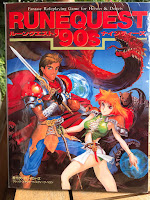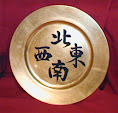Some of the many races and creatures of Umathela have already been mentioned on this blog:
- Iqari
- Lascerdans
- Plant-Men (Dryads, True Elves, Black Elves [Voralans], and Red Elves [Slorifings])
Other sentient races:
- Dwarfs. Umathelan Dwarfs are vegetarian.
- Grey Giants.
- Timinits (several sub-species); they are allied with the Westerners.
- Trolls (Dark Trolls and Trollkin) in the Tarmo Mountains. Hot Trolls do not live in Umathela but further south in the jungles.
Animals:
- Boars and hogs; both domestic and wild. And sheep. Swine and sheep are almost the only domesticated meat animals of Umathela. Fowl/poultry are uncommon; cattle non-existent.
- Horses are not native to Pamaltela and hence extremely rare. Only Westerners own horses, which are exclusively used as mounts, and never as beasts of burden.
- The Middle Sea Empire tried to introduce mules, but for some reason they all died out in Pamaltela.
- Draught animals: the standard Umathelan draught animal is the giant hog used to haul carts. In other parts of Pamaltela, wagons are simply dragged by teams of men.
- Although Theyalan in origin, Umathings do not keep alynxes as companions but dogs (that are similar to the Catahoula cur).
- Wolves of various sizes and types. Large wolves may be used as mounts by some monsters.
- It is rumoured that the Zistorites have managed to domesticate large flightless birds called horseclaws, which they mount much in the same fashion as the Dragonewts mount the (larger) demi-birds.
Monsters:
- Giant arthropods.
- Giant insects. Trolls raise and breed all kinds of giant insects.
- Undead.
From the Gloranthan Bestiary:
- Charnjibber; a highly chaotic predator whose size and shape are constantly changing. Greatly feared throughout Pamaltela.
- Gargoyle; lives in the mountains.
- Grue (large chaotic monster; bipedal, huge deformed head; their blood is corrosive); lives in eastern Umathela near rivers
- Mountain Trolls (low intelligence)
- Sabre-toothed Cat
- Skybull
- Succubus
- Titanothere
 |
| Mottled Condies |
From Trotsky's site:
Animals
- Vangono's Horror (a kind of larger hyaenodon created by Vangono, the Pamaltelan God of War)
- Uintal (the only pachyderm living in cool Umathela)
- Mottled Condy (the most common herd animal of Umathela)
- Manatee (in the Dashomo and Jorkar Seas)
- the Umathelan crocodile, small and swift
- Pteranodon
- Green Mamba, deadly venomous tree snake
Monsters
- Fright (a degenerate, trollish ape-like creature).
- Hoon (again, a degenerate, trollish bat-like large monster); lives in the mountains.
- Shadowstalker (darkness-related, wiry ape-like creature with a long neck); lives in forests.
- Watchwere (hulking ape-like chaotic horror); have the ability to see through any object as if it were transparent.











